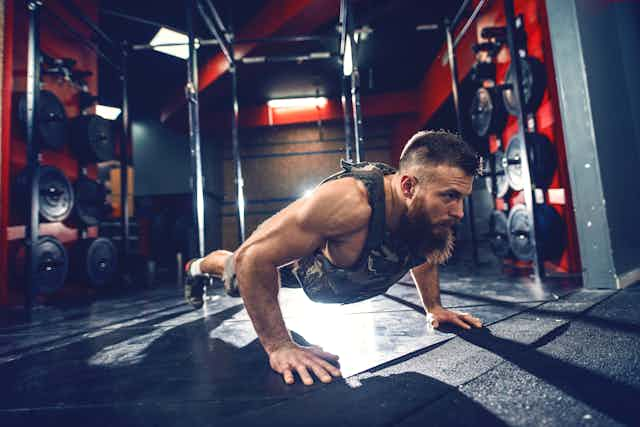Meta boss Mark Zuckerberg recently shared on Facebook and Instagram that he had completed the “Murph” challenge, which is named for Navy Lieutenant Michael Murphy, who was killed in Afghanistan in June 2005, aged 29.
This gruelling CrossFit workout involves running one mile, doing 100 pull ups, 200 push ups, 300 squats and running another mile, all while wearing a weighted vest.
While the Murph challenge will build your strength and endurance, it’s important to approach it carefully, as there can be risks, especially if you’re trying this type of exercise for the first time.
CrossFit was developed in California more than 20 years ago, and has since grown into a worldwide phenomenon with an estimated five million participants attending thousands of CrossFit gyms (called “boxes”) globally.
It’s a high-intensity fitness regimen incorporating elements from a variety of sports and different types of exercise (its name is derived from “cross-discipline fitness”). The CrossFit workout changes daily, with participants typically doing a workout about three times a week, depending on their fitness level.
Workouts are tailored to individuals’ fitness and experience levels, though typically they include a mix of gymnastics, power lifting, and cardio such as running.
The toughest CrossFit workouts are known as “hero” workouts, dedicated to deceased soldiers such as Murphy.
The ‘Murph’ challenge
This particular workout comprises the following, done as fast as you can:
- one mile run
- 100 pull ups
- 200 push ups
- 300 squats
- one mile run.
Notably, all of the above is completed while wearing a weighted vest. Men wear one weighing 20lbs (9.07kg) and women wear one weighing 14lbs (6.35kg).
The runs must be at the beginning and end of the workout, but the pull ups, push ups and squats can be split up as required. For example, beginners might start with 20 rounds of five pull ups, ten push ups, and 15 squats. When more advanced, this can progress to ten rounds of ten pull ups, 20 push ups and 30 squats.
The workout is completed periodically in CrossFit boxes worldwide, and thousands of participants undertake it annually on Memorial Day in the US, as Zuckerberg did.

According to Marathon Handbook, an exercise resource built by a team of coaches, runners and fitness enthusiasts, it takes an average of 63-80 minutes for beginners to complete this workout, 50-58 minutes for intermediates, and 40-45 minutes for advanced athletes.
Zuckerberg said he finished the workout in 39 minutes and 58 seconds. With a time like this, it’s little surprise he’s been described as the “toughest CEO in the valley”.
A difficult workout
The Murph workout is challenging because it stresses most major muscle groups: the back and shoulder muscles with the pull ups, the chest with the push ups, and the legs and torso with the squats. This is on top of the significant cardio challenge of the one-mile run at the beginning and end, and the intensity the vest adds.
Research I’ve done with my colleagues has shown that running with the addition of the weighted vest in CrossFit increases heart rate by 11 beats per minute, increases the amount of oxygen we consume, and increases the amount of calories we burn compared to no vest. This is because the body is working harder so needs more fuel to produce energy. So, this workout will build excellent cardiovascular fitness while developing strength and muscular endurance in the upper and lower body.
Read more: Weighted vests: should you use them during exercise?
What about the risks?
A systematic review from 2017 involving 13 studies and 2,326 participants concluded that CrossFit has similar injury rates to other exercise programmes.
These findings are supported by a questionnaire of 132 CrossFit participants, that reported an injury rate of 3.1 injuries per 1,000 hours of training.
This rate is comparable to competitive contact sports such as rugby, as well as gymnastics, weight lifting and power lifting. Interestingly, it’s lower than that seen in recreational running (7.7 per 1,000 hours) where the biggest risk factor for injury is running volume and duration, suggesting repetitive strain injuries are common.
Injuries in CrossFit are most likely to be to the shoulders and lower back, and typically happen during either power lifting or gymnastics. Risk factors for injury include greater length of participation in CrossFit (how many years you’ve been doing it), a greater number of weekly training hours, being taller and being heavier.
Rhabdomyolysis: a dangerous condition
One risk of extreme, unaccustomed exercise such as someone attempting Murph for the first time (this could be someone who doesn’t routinely do CrossFit-like exercise, or even someone who does) is rhabdomyolysis.
In rhabdomyolysis, muscle is damaged causing extreme muscle soreness and the release of proteins into the blood. These proteins such as myoglobin (a protein in muscle that absorbs oxygen) can damage the kidneys when they enter the blood in large quantities, which may occur, for example, when the muscle breaks down.
This condition is often seen in crush victims, but rhabdomyolysis as a result of extreme, unfamiliar exercise (exertional rhabdomyolysis) accounts for almost half of cases. While rare, it can be life-threatening.
Read more: How to prevent injury from sport and exercise
Murph is truly a gruelling workout and will likely be a staple for many fitness addicts on Memorial Day for years to come.
For those looking to try Murph for the first time, perhaps have a go without the weighted vest. Beginners might also try 20 rounds of five pull ups, ten push ups and 15 squats, which allows the opportunity for rest between rounds.
You can also try walking the first and last mile or doing specific training to build up towards the full Murph.

